Visions of the Baojun: Donald Trump and the Pathological Large Intestine Archetype in Classical Chinese Medicine
By Heiner Fruehauf
National University of Natural Medicine, College of Classical Chinese Medicine
Beware of the pathological Metal type! When such a person ascends into a position of power, the world will be plunged into chaos.
– Wang Fengyi, fl. 1900
Note on Chinese Medicine Holomap image: click to view larger version
According to the cosmological foundations of classical Chinese medicine, the physiological processes of the human body can be categorized into 12 functional networks. These networks are conceived to resonate with the various powers of nature as they manifest themselves during the 12 months of the year and the 12 double-hours of the day. Each time period features a set of normal “physiological” occurrences. Similarly, the scientists of ancient China also defined the shadow sides of macrocosm and microcosm, by specifying catastrophic diversions from regular weather patterns in nature and describing pathological expressions by the organ networks of the human body.Since the recent presidential elections in the USA elicited considerable global concern, it may be helpful to utilize the sophisticated systems science of Chinese medicine to assess the constitution of Donald Trump and his disposition for future action. If we apply the system of the 12 archetypal forces used by all ancient civilizations (i.e., the 12 Neters of ancient Egypt, the 12 Gods of ancient Greece, the 12 apostles of Jesus, the 12 knights of King Arthur’s Round Table) and look at it through the specific lens of Chinese symbolism, the new president-elect emerges as the epitome of the pathological Large Intestine archetype—the baojun (tyrannical despot of the Warring States period of ancient China; more recent incarnations are Hitler and Mao). Below is an outline of this shadow variant of the Large Intestine archetype. China’s primordial wisdom classic, the Yijing (Classic of Understanding Changing Phenomena Through the Science of Symbols) proclaimed early on that the better we understand the inner nature of a phenomenon, the better we are equipped to deal with its consequences in the future.In the classical Chinese system of the 12 organ networks, Large Intestine function is traditionally described by a complex array of symbolic markers: in terms of the five phase element system, the Large Intestine is classified as a “Metal” organ; in the six confirmation system, it belongs to “yangming;” in the ancient holomap referred to in the Huangdi neijing (Yellow Emperor’s Classic of Medicine) and later alchemical texts, it is associated with the 2nd month of spring (eryue : March 7 – April 5) and the time of sunrise (richu: 5-7 am). These markers reveal the following tendencies of the pathological Large Intestine archetype:
1) Separation Consciousness, Ostentatious Materialism and Apotheosis of the Profane
The 2nd month of spring includes the vernal equinox, a 2-week time period classified in the ancient Chinese agricultural calendar as chunfen 春分. This term can literally be translated as “the time in spring when all things emerge from the womb of unity and are thrust into the post-natal stage of separation;” a time when all life forms transition from their invisible gestation to sudden material emergence in the form of sprouting vegetation, stirring insects and the return of hibernating animals. At this time the forces of nature, after a long period of planning and laboring underground, are finally able to manifest a concrete and visible outcome. The Large Intestine, not surprisingly, is therefore associated with the concepts of deliverance and production. Even the anatomical large intestine stands out from the other organs by visibly ex-pressing copious amounts of physical substances outside the body. By extension, all material wealth in ancient China was based on agricultural production, and all agricultural plentitude was dependant on fertilization, and human and animal feces have been the main source of fertilizer for more than two millennia.
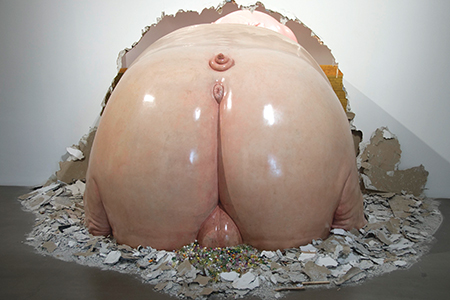
Sculpture by Chen Wenling, from the exhibit The God of Materialism, (Beijing, 2008)
Figuratively speaking, the Large Intestine is thus “defecating” the material world into existence, and along with it everything that money can buy. In chapter 12 of the Lingshu (Magical Pivot) section of the Huangdi neijing, the Large Intestine is aptly associated with the Yangzi River, termed Jiang 江 (river of material production). When China joined the industrial age, most of its production hubs were installed in Shanghai on the banks of the Yangzi—the allegorical “anus” of China where the Yangzi issues into the sea. The Chinese character for anus, furthermore, is gang 肛 , a term that literally means “the production organ.” In an extended sense, the Large Intestine position within a management team of 12 functionaries would be charged with the deliverance of palpable and quantifiable results—a key task tended to by one of the team’s most powerful members, yet rife with the potential for overconfidence, corruption and a tendency to place material and monetary values above else.
At the etymological core of the Chinese words Yangzi and anus is the character gong 工 (material production). In its most literal sense, the term gong denotes craftsmanship, specifically as it pertains to the construction of buildings. It is significant that one of the asterisms associated in ancient Chinese astrology with the position of the sun in the 2nd month of spring are the Lou Stars 婁宿, which can be rendered as Highrise Constellation. Alternatively, Lou can be translated as Heavenly Dung Pile, situated right next to the Heavenly Sewer of the Kui Constellation 奎宿, a second celestial marker for macrocosmic Large Intestine activity. While the assembly of edifices built in accordance with the numbers and ratios established by nature itself once defined the venerable role of the ancient master builder, the erection of absurdly tall superstructures has always been seen as an expression of human hybris, most notably exemplified by the Tower of Babel. Throughout his business career, Donald Trump has exhibited an obsession with ostentatious real estate projects such as the gilded Trump Tower on Fifth Avenue, Trump World Tower in midtown Manhattan, the 24-karat-gold plated Trump International Hotel and Tower in Las Vegas, the bankrupt billion dollar Trump Taj Mahal casino in Atlantic City, accompanied by numerous unsuccessful attempts to construct the world’s tallest building. From this perspective, Trump’s fixation on “making America great again” by launching a host of high-profile infrastructure projects is a typical expression of the pathological Large Intestine archetype.
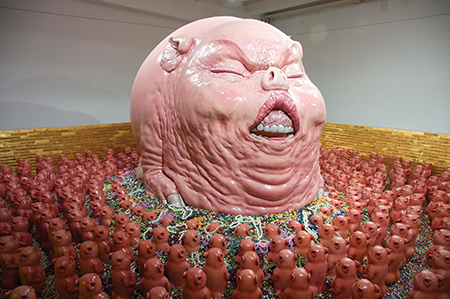
Sculpture by Chen Wenling, from the exhibit The God of Materialism, (Beijing, 2008)
To ancient observers of natural cycles, the emergence of all life forms in springtime was a sacred moment, linked to positive values such as the return of light, life and rebirth. In their eyes, the material world was a living vehicle for the multiform manifestations of the invisible Dao. In the defining chapter about organ function in the Huangdi neijing, the Large Intestine is thus literally designated as the “transmitter and transporter of the Dao.” According to the evolutionary phenomenology outlined in the Yijing, moreover, the Metal element is the densest and most structural of the Five Elements, and its position is the farthest removed from the spiritual origins of the watery Dao: Water engenders Wood, Wood engenders Fire, Fire engenders Earth, and Earth finally engenders Metal. At the same time, however, Metal is the element that is charged with an inherent mandate to connect and guide every living thing back to its primordial source. Metal, after all, once again engenders Water.
In addition, the character gong 工 is a clear image of the process of tethering all earthly production to the immaterial realm of Heaven. The healthy Large Intestine type, therefore, perceives the material world as a manifestation of divine spirit and sees all things pointing back to the Dao. This pointing action by the executive of the Metal mandate is what bestows meaning to the material world—the German word for meaning is bedeuten, which means “to point at something other than itself.” Note that the lead acupuncture point of the Large Intestine channel is prominently situated at the tip of the index finger. When this guiding beacon is aimed in the wrong direction, the highest level of meaning is seen in the material nature of things themselves and a perversion of this sacred “business” has occurred. This represents one of the most fundamental “sins” in all ancient wisdom traditions: the creation of a world wherein selfish consumers, greedy businessmen and corrupt rulers elevate the accumulation of material possessions to the highest level of importance, and where the stuff of creation is no longer seen as a vehicle for the Dao. In this scenario, money is seen as the only force that can reliably move and control matter. In contrast, the physiological role of the Large Intestine was defined in the Huangdi neijing as master craftsman of the material world through bianhua 變化—the process of spontaneous engenderment wherein something is manifested out of nothing. During the last 2,000 years, this magical attribute has become personified in the form of cultivated masters such as Jesus or Sai Baba, who were renowned for their command of the material world yet made it a priority to remind their contemporaries about the exalted nature of the creative spirit animating all matter. The Trump-styled images of the self-made businessman, the industry boss who delivers instant results, and the deus ex machina entrepreneur of guaranteed change are contorted echoes of this capacity.
In sum, the pathological Large Intestine type exhibits a constitutional denseness expressed in the following markers of separation consciousness: a conviction that money and real estate are king (instead of understanding “business” as the self-effacing task of supplying earthly vessels as transmitters and signifiers of a higher purpose); that the material world is unanimated and can therefore be exploited at will; that there is no difference between natural and artificial things; and, finally, that everything is profane and nothing is sacred. Visions of a Trump presidency, therefore, reveal a caricature version of the narcissistic materialist tendencies that already predominate the standard aspirations of modern lifestyle—an in-our-face emblem of the “Large Intestine” pathology of our time.
2) Autocratic Supremacy, Minority Oppression, and Sexual Abuse
The positive personification of the Metal element is inherently associated with the qualities of leadership and administration, a paragon of shining and incorruptible virtue. The Lung, for example, the Large Intestine’s Metal partner is designated as the “Grand Counselor” of the organ systems in chapter 8 of the Huangdi neijing. Considering the violent history of the Warring States period, it is no surprise that many of the Daoist and Confucian writings created between 600 – 220 BCE appear to urge the military rulers of their time to embody the benevolent qualities of the sage king. The 3rd century BCE texts of the Xunzi and the Lü shi chunqiu (Master Lü’s Spring and Autumn Annals), for instance, pointed out the close etymological relationship between the Chinese words jun 君 (leader) and qun 群 (flock, community). “Jun means qun: the role of the ruler is defined by the concern for his people” echoes the Baihu tong (Discussions in the White Tiger Hall) in the 1st century BCE, the approximate time that the tenets of Chinese medicine were mapped out in the Neijing.
Appropriately, the Metal Virtue among the so-called Five Virtues recorded in Han dynasty Confucian texts is yi 義—a term comprised of the peaceful image of a sheep 羊 covering the combative symbol for self or ego 我. Yi, therefore, expresses a state of self-restraint that resonates with the Metal season of autumn when nature begins to withdraw its forces of self-expression; it can be rendered as selflessness, justice, equality or brotherhood/sisterhood. The term yiqi (willingness to sacrifice oneself for the sake of the team) traditionally represented a Robin-Hood-like code of brotherhood that was expected not only of the country’s administrative leaders, but featured prominently in informal clan organizations such as martial arts societies and even criminal gangs.
The characteristic of treating every living thing fairly and equally was specifically tied to the Large Intestine position in Warring States era cosmology by China’s first dictionary Erya (Approximate Definitions). The 3rd century BCE text contains a list of enigmatic characters signifying the 12 months of the year, which have recently been identified as the names of the month-gods of ancient China. Within this catalog, the designation associated with the 2nd month of the year is Ru 如. This pictogram contains the major components of the name for the asterism Lou 婁, once again underscoring the Large Intestine’s association with this constellation. Furthermore, the word ru means “equal,” “similar” or “the same.” Quite literally, the compelling powers of March were thus personified as “The Equalizer.” Most modern equality movements can find their essential momentum rooted in this archetypal force, including Robin Hood’s example of vigilante justice. Even in candidate Trump’s case a good part of his popular charisma relied on the stratagems of economic justice and class fairness.
The shadow side of this impulse—precipitated in our time by what is apparently perceived by Middle America as a mind-boggling avalanche of equal rights for women, immigrants, homosexuals and transsexuals—is a fear-based drive toward uniformity and the ensuing urge to equalize phenomena that are diverse and “perverted.” Remember that the defining Neijing chapter on organ network function states that the Large Intestine is the “agent of bianhua;” a term that can alternatively be translated as either “the creation of diversity” or “the transformation of perversion.” This idiosyncratic feature of the 21st century has ushered in one of the greatest perils of our time, brought into razor-sharp focus by the looming prospect of a Trump presidency: in an era of unprecedented racial and cultural diversity, self-styled equalizers are emerging all over the globe, propped up by collective anxiety and characterized by bellicose calls for conformity. And now even the United States, once respected as the world’s beacon of freedom and diversity, appears to have joined the fray.
This editorial is by no means intended to offer yet another analysis of the social or political reasons for this development, but seeks to illuminate its archetypal and medical dimensions. In the human body, diversity first and foremost exists in the digestive tract, which is populated by trillions of bacteria that can be categorized into approximately 10,000 different strains of microbes. While sparse in the stomach and small intestine, the lower bowel features a densely-populated microbial ecosystem that make it the “tropical rainforest” of the body. Modern pyrosequencing techniques have identified at least 5,600 separate strains of bacteria living inside the large intestine. Among these, about 400 species that occurred in abundance in the feces of healthy adults were identified during the 1940s. A mere 75 years later, the number of strains that compose 99% of typical adult fecal matter has been reduced to 30-40. In other words, colon microbiome diversity has been reduced to less than 10% during the last 75 years when the ingestion of industrialized foods and frequent antibiotic use have eclipsed holistic systems of nutrition and healing. As mechanized farming practices have championed the cultivation of monocrops and our planet’s overall biodiversity is experiencing a state of sharp decline, the poor yield in the internal “farming” of our resident microbes is mirroring this downturn.
The diversity of our external and internal environments, however, involves more than just quantitative features. A recent avalanche of research on the connection of the gut-brain axis has shown that microbiome deficiency has the potential to cause us to become incoherent, simple-minded, anti-social and even criminal. Many researchers have shown a clear link between poor intestinal health and autism, ADHD, GAPS, Tourette’s Syndrome and other cognitive disorders. The symbolism of Chinese medicine, moreover, would venture so far as to state that a lack of microbiome complexity—the state of inherent refinement and sophistication characterizing all Metal organ networks—will invariably give rise to a type of choleric, oversimplifying and fear-mongering mass consciousness that derides most aspects of social diversity. It is not too difficult to glimpse many of the personal traits of Donald Trump—himself a proud junk food aficionado and steadfast avoider of probiotic fare—and the hard-core Trumpites in this description.
In an eerie display of symbolic happenstance, the ancient Chinese holomap indirectly links the pathological Large Intestine archetype to the State of Lu 魯國, literally “Land of the Simpletons.” Traditionally, the stellar constellations where the sun resides during the 2nd month of the year were traditionally associated with Lu, ancient equivalent of modern day Shandong Province—on one hand regarded as the land of the rising sun and its moral equivalent, the humanistic enlightenment ushered in by its favorite son Kongzi (Confucius); on the other, as its opposite: the home turf of a populace distinguished by “uncouthness,” “surliness” and “vulgarity.”
Unfortunately, the scenario of a boorish president spouting populist messages that promise to even the economic score while inflaming anti-immigrant, anti-Muslim and misogynistic sentiments is not the worst fallout associated with this archetype. Its most alarming quality is the inherent drive to win at all cost, usually by violent and underhanded means, and to dominate and rule by force. Extreme examples of this pattern are dictators such as Hitler, Mussolini, Stalin, Mao Zedong or Saddam Hussein. In the democratic fabric of United States history, more contained examples of this archetype are Richard Nixon and Joseph McCarthy.
The tendency to seek a position of dominance under the pretense of equality is clearly expressed in several markers characterizing the position of the Large Intestine. According to the ancient Chinese calendar, the 2nd month of the year contains the 2-week period chunfen (Vernal Equinox), literally “the time in spring when yin and yang are equal.” With the exception of the Autumnal Equinox, this interval marks the only time in nature when the hours of daylight and darkness are identical in terms of quantity. However, in the Han dynasty wheel of the Twelve Tidal Hexagrams (shi’er xiaoxi gua), the hexagram designating the energetic momentum of the 2nd month reveals the qualitatively lopsided nature of this position. Hexagram 34 bears the title Dazhuang (Yang Dominance) and represents one of the clearest images for the domineering power of the Large Intestine. While the preceding tidal hexagram marking the position of the 1st month (Hexagram 11, Tai/Balance; associated with Lung function) had conveyed the picture of yin-yang balance by featuring three yang lines underneath an equal amount of yin lines, Hexagram 34 has four yang lines at the bottom and two yin lines at the top, revealing its inner nature: (male) dominance and (brute) force.
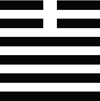
Hexagram 34, Dazhuang
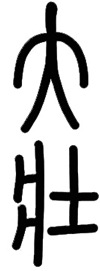
Ancient Chinese seal script version of the pictogram for Hexgram 34, Dazhuang
Generally speaking, Hexagram 34 is perceived as a positive omen in Chinese culture, illustrating the victory of the forces of light over darkness. Yang moves decisively into a position of dominance, producing the image of “Thunder in the Sky” under the appellation Dazhuang, a title that can alternately be rendered as Big and Strong, or Masculine Power, or Patriarchal Supremacy, or Yang Dominance. Quite obviously, however, the image of the righteous strongman entails more than the triumphant return of everything that is good and just and virtuous. It also includes the coarse tendencies of the uncultivated Large Intestine type: booming and blundering, and foreshadowing a penchant for torture, sexual abuse, maltreatment of minorities, misogyny, derision of the handicapped, and disdain for the losers—phenomena that have already characterized the life of businessman, reality TV persona and political candidate Trump. We can always hope that these impulses become transformed into their positive potential during a Trump presidency…
The positive archetype described by Hexagram 34 projects the image of military strength behind a righteous revolution. China’s most preeminent example for this phenomenon, directly associated with the cardinal position of the rising sun and the return of the forces of light, is King Tang 湯王 (literally, the Sun King). Tang was an erudite scholar turned revolutionary who became the first ruler of the Shang dynasty around 1650 BCE. He is remembered for the noble objective to “drain the swamp” of decadence and corruption perpetrated by King Jie of the preceding Xia dynasty. Chinese history remembers King Jie as a tyrant who indulged in wasteful real estate projects such as extravagant palaces, towering dikes and a lake of wine on which his court floated about. Anyone who remonstrated with him was put to death or driven from the court, while evil loyalists were elevated to high office. Warned by the righteous minister Yi Yin that his Mandate of Heaven was about to expire, Jie supposedly exclaimed: “So you too warn of evil omens! Beware that I am like the sun in the sky. Only when the sun perishes, I too shall be destroyed!” While Jie ‘s image appears to be a composite of attributes describing the corrupt Large Intestine archetype, Tang is remembered for its positive aspects, especially the ardent commitment to righteousness and the restoration of order. “I fear God,” Sima Qian’s Shiji (Records of the Grand Historian) quotes King Tang, “and thus it is my mandate to set things right in the world. Currently the Country of Xia is drowning in sins, and so it is Heaven’s will that it becomes overthrown.” Other notable examples for the positive aspects of this archetype are China’s incorruptible ministers of state, starting with the sage Confucius (551-479 BCE) and the uncompromising Confucian counselor Dong Zhongshu (179-104 BCE), as well as a host of subsequent lawmakers who propagated models of socially responsible governance. All of them have been memorialized for their advocacy of the concept of public service while trying to restrain the self-serving impulses of their rulers’ ego.
It is no coincidence that many historical dictators have adopted the archetypal fusion of the strong man and the transformative powers of the rising sun as the most prominent icon of their propaganda machines. The time period from 5-7 AM, traditionally associated with a culmination of Large Intestine function, is called richu 日出 (Sunrise) on the Chinese holomap. Posters from the 1950s and 1960s show Mao Zedong as a personification of the Communist hong taiyang (Rise of the Red Sun), while Hitler’s swastika logo harkens back to an ancient Germanic solar symbol.
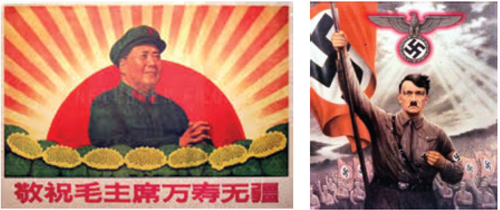
Propaganda posters associating Mao Zedong and Adolf Hitler with the primordial image of the rising sun
In this context it is also important to remember that the Chinese term for Large Intestine (dachang 大腸) is not only a phonetic and etymological reflection of the hexagram title Dazhuang, but that it quite literally means Rising Sun Organ or Masculine Power Network. The anatomical large intestine, after all, is the most powerful muscle in the physical body. It typically asserts itself suddenly, forcefully, and with immediate results in the material sphere. The Large Intestine channel, moreover, traverses the prominent aspects of the human forearm and biceps, where muscular prowess manifests itself most prominently. The principles of work (gong 工), flexing muscles (Dazhuang), and their resulting toil (“toilet”) are thus synthesized in the etymological field characterizing Large Intestine function.

Nazi and Communist propaganda posters emphasizing the stylized Large Intestine channel muscles of “The Worker,” backbone of the “proletarian revolutions” led by Lenin, Hitler and Mao
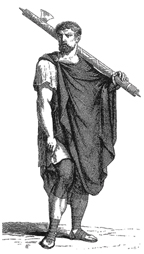
Roman lictor carrying fasces, insignia of imperial authority
As outlined in detail above, the symbolism of the 2nd month includes the potential rise of the baojun, a domineering strongman who is swept into a position of unexpected power by a wave of mass fears and prejudices, typically fueled by assurances of fortitude and work for the common man. In the sphere of Western typology, it is the fasces of imperial Rome that are his emblem: a cylindrical bundle of rods from which an ax head projected, carried by bodyguards before a Consul to indicate his military power. Originally devised as insignia for the state of law and order, Hitler and Mussolini—both classic exemplars of the negative Large Intestine archetype—adopted the fasces as the logo of fascism during the early 20th century. Since then, the bundle of cudgels has become a universal icon for narcissistic dictators.
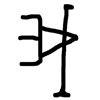
Ancient Chinese oracle bone version of the pictogram wo (combative and self-serving ego consciousness)
In a show of the timeless relevance of symbolic expression, the Chinese term for “ego consciousness” (wo 我), defining feature of the baojun, appears to resemble an Eastern equivalent of the Roman fasces. “The word for ‘ego’,” explains the authoritative annotator of the 2nd century dictionary Shuowen jiezi (Explication of Simple Graphs and Analysis of Complex Characters), “represents an image of canes and axes that are used to assert one’s self.”

On the reverse side of the Winged Liberty Head (“Mercury”) dime (1916), a bundle of fasces juxtaposed with an olive branch was intended to symbolize America’s readiness for war, combined with its desire for peace
Unexpectedly, the early 21st century has become fertile ground for the rise of the baojun; literally, “the strong man who explodes onto the scene and rules with brutal and oppressive force.” Since the age of the incorruptible sage king ideal is long gone, it more than behooves us to anticipate and guard against the questionable baojun potentialities that the rise of Donald Trump and similar figures in Russia, France, Austria, Holland, Hungary, Poland, and the Philippines have ushered in: the reign of egomaniacal willfulness and the quest for autocratic supremacy; the looming threat of martial law and unconscionable paramilitary forces; and the subversive agenda of minority oppression, fueled by a pathological compulsion for ethnic cleansing and other twisted feats of “equalization.”
3) Corrupt Business Practices, Environmental Pollution, and Ethnic Cleansing
Purity, cleanliness and refinement are defining features of the Metal element. It is precisely because the healthy Large Intestine is the cleanest of the 12 organ “officers” that it is tasked with handling and expelling the system’s refuse. It represents the body’s premier drainage ditch—just like the associated asterism Kui is described as a “heavenly gutter;” and the Yangzi River, Asia’s longest and most voluminous body of water (directly associated with Large Intestine function in chapter 12 of the Lingshu section of the Huangdi neijing), has always been China’s primary receptacle for the detritus of the country’s agricultural and industrial production.
Archetypal professions that embody physiological Large Intestine function therefore involve the maintenance of cleanliness, appearance, transparency and precision in the largest sense of this word field: i.e., wastewater engineers, garbage collectors, plumbers; environmental professionals; economists, accountants, statisticians, mathematicians; colon therapists, dermatologists, dentists, make-up artists, fashion models, image consultants; loyal and punctilious workers, conscientious educators, clean-handed administrators, incorruptible politicians, virtuous financiers, and upright generals. If this vital function of maintaining cleanliness becomes debased, pollution on all levels occurs. Typical examples for the degenerate Metal type are the big bosses of industry who ignore environmental concerns to maximize profit, unethical politicians with a penchant for pornography, accountants who cook the books, etc. A particularly dangerous category of devolved Large Intestine Metal features an obsession with perverted forms of cleanness, as represented by the fanatic strongman espousing “whiteness” and “racial purity,” in the worst-case scenario accompanied by intentions of “ethnic cleansing.”
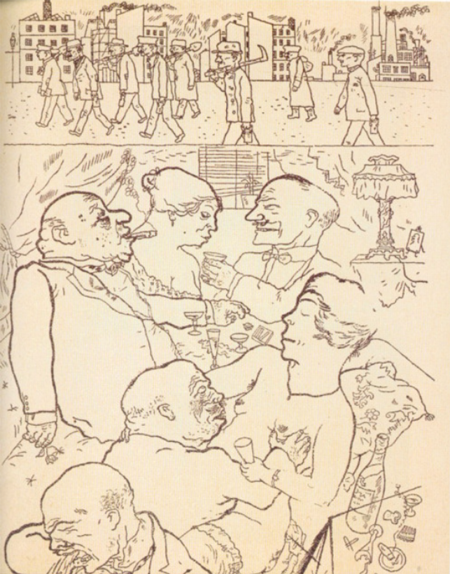
George Grosz, caricature of profiteers, politicians and prostitutes in Berlin, 1920
As is typically the case, most Large Intestine types tend to exhibit traits that are situated at both ends of the spectrum of associated qualities. In Trump’s case, his publicized propensities for unethical business practices, the vilification of climate change theory, shady sexual advances and ethnic whiteness are paralleled by the almost obsessive desire to stay “clean”: “No alcohol, no tobacco, no drugs, no coffee” is reportedly one of his personal mantras.
The psychologist David Livingston Smith, in his recent book Less Than Human—Why We Demean, Enslave, and Exterminate Others, raises another point that is relevant for this part of our discussion about the Metal element in general and Large Intestine pathology in particular. His writings define the essential mindset behind the phenomenon of ethnic cleansing and the denigration of specific groups of people. The parochial pursuit of ethnic homogeneity, he argues, is related to the belief that a person can have human appearance but lack human essence, and the delusion that a thus dehumanized group of people is composed of human-looking creatures endowed with sub-human spirit.
From the perspective of ancient Chinese cosmology, most features related to the evolution and cultivation of the human soul are related to the terms hun 魂 (spiritual soul) and po 魄 (vegetative/animal soul), of which especially the latter is directly associated with the 2nd month of the year and the phenomenology of the Large Intestine. “The 2nd month of the year marks the birth of the po spirits,” states a classical text, identifying this period as the birthplace of the material world’s physical shell (which at this point is primarily animated and compelled by low-level instincts). Pertinently, the anus was called pomen (gateway of the po spirits) in ancient medical treatises, a term that can also be translated as the Gate of Low-Level Urges and Their Associated Dregs. The hun spirits, in contrast, represent a more refined aspect of the soul, related to higher levels of human consciousness and regarded as the result of mental and spiritual cultivation. Hun and po, therefore, are ancient Chinese terms for aspects of the higher and lower self. It is important to note, however, that the concept of the po spirits includes more than just the instinctual aspects of the corporeal self. In their natural state, the po spirits are striving for the uniquely human qualities of restraint, transformation, cultivation, refinement, and evolution—vital agents promoting the Metal destiny of the Large intestine.
It is a life-long danger for Large Intestine types to become mired in the lower echelons of the po soul spectrum. Similar propensities, by the way, have been ascribed by Western astrologers to constitutional types influenced by Aries, the Western zodiac period that equates most closely to the 2nd month of the traditional Chinese calendar. The anthroposophical writer John Jocelyn, for instance, describes this tendency most aptly in his classic Meditations on the Signs of the Zodiac in 1965:
Unique in this sign is the intense instinct factor, a quality more akin to the animal than to man becoming Christ-conscious [cultivated in one’s higher self]. It is through this avenue of instinct that Aries expresses itself in abandoned disorder; in outrushing rashness, ram-headed impulsiveness, changeful activity, and digression; in a riot of rude strength and extreme self-will; in excess and extravagance; in explosiveness, combat, and courage; and even in foolhardy militancy and madness. Willful and headstrong when young, many Aries persons fail to achieve the necessary caution and control even in their mature years and they continue to go to extremes. Self-restraint, calmness, poise and consideration for the feelings of others are not the virtues of Aries souls, unless they have worked upon themselves for the sake of the soul and spirit… The influence of instinct, so marked in Aries, is at the root of the disruptive, impulsive explosiveness in its natives whenever there is lacking a proper sense of direction because the spiritual self-consciousness is not yet awakened.

Modern expression of the phenomenology of ru 如 (“uniform horde”): Manipulation of mass consciousness by Hitler and Goebbels in 1943
While uncultivated Large Intestine personalities may exhibit a talent for the creation and administration of material commodities, there is a distinct tendency to view the world’s bounty as inanimate matter that can be utilized and exploited for maximum profit. Most problematic is the related propensity to dehumanize individuals or entire groups of people by treating them as zaopo 糟粕, “dispensable trash” devoid of hun and motivated by low-level po urges. Large Intestine types are masters of manipulating mass consciousness, because they tend to look at animated and inanimate things alike as bulk commodities—hordes of people that can be exploited or expunged or shipped off to war without consideration for their human essence.
It is therefore not surprising that the term po is part of an etymological word field that reveals all of the relevant topics touched upon in our discussion of the Large Intestine: low-level animal instincts (po 魄) linked to the physical body and the ego, worthless trash (po 粕 or 魄) and, of particular interest in the context of this argument, the waxing moon’s victorious campaign to reclaim authority (ba 霸 or 魄) and the associated figure of the tyrannical overlord (ba 霸) of the Warring States period.
4) Harebrained Antics, Twisted Facts, and Lewd Manners
The Large Intestine themes of purity and corruption are further perpetuated by the correlated icon of the rabbit/hare. Not only is the hare, in Eastern and Western mythology alike, an emblem of lunar renewal. In the eyes of ancient Chinese observers, the active forces of the 2nd month “spit out” the myriad manifestations of life. The month marker ru 如 is composed of the characters for woman 女 and mouth 口, alluding to the myth that rabbits and hares—the zodiac animals marking the 2nd month of spring in the Chinese calendar—deliver their abundant litters orally. Prolific breeding, after all, is the animal’s “trick” to survive in a world where every creature wants to hunt it. Another well-known trick is the hare’s ability to outrun predators through evasive zigzag maneuvers. In both East and West, the rabbit has therefore become a universal symbol for fertility, sexual desire and vitality. On the negative side, the rabbit image connotes unbridled sexuality, impurity (the Old Testament describes it as a non-kosher animal), and dishonest shenanigans. “Wily rabbit has three burrows,” states a Chinese aphorism, reflecting both the animal’s regenerative power—akin to the rising sun and springtime—as well as its ability to utilize strategies of guile and deceit for the sake of survival.
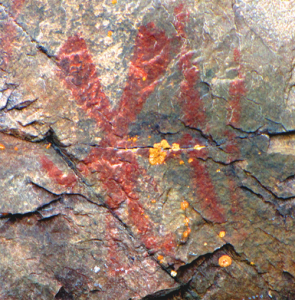
Pictogram of Nanabozho the Great Hare on Mazinaw Rock, Ontario
These traits have made the hare a universal motif for the trickster figure that features prominently in the myths of many native traditions. Tricksters are archetypal characters who carry secret knowledge, often utilized to play tricks or otherwise disobey normal rules and conventional behavior. The Olympian god Hermes was a famous Trickster, patron of thieves and inventor of lying. Nanabozho the Great Hare is a powerful figure found in the tales of many Native American tribes. American petroglyphs depicting Nanabozho, incidentally, resemble the pictographic features of the ancient Chinese title for Hexagram 34, Dazhuang (tidal hexagram illustrating the energetic momentum of the 2nd month). He is both a revered culture hero—creator of the earth, bringer of light and fire, and transmitter of sacred rituals—and a clown, a liar, a thief, a lecher and a cunning predator; an ambivalent amoral character dancing on the line between right and wrong.
The Great Hare’s predisposition for dancing on the edge of sacred truth and habitual lying is also found in Western descriptions of Aries personalities. Once again John Jocelyn:
The destiny and genius of Aries is truth, and the truly balanced Aries soul is content with truth only. Ill-direction in thought and action, error, a flair for the false and sometimes for the fatuous become the lot and lesson of Aries persons whose nativities show unbalanced factors or inharmonious aspects.
 Parallels between the aspects of Large Intestine typology manifested in the figure of the Great Trickster and Trumpian modes of action are obvious: impervious twister of facts, bounce-back scam artist, celebrity clown, sexual predator. Yet the trickster image may also cast a shimmer of light on the implausible phenomenon of the Trump presidency. Although Nanabozho can unleash disorder upon the world, he is not considered evil by Native American traditions. He is regarded as a necessary catalyst for understanding the sacred, an adjuvant that indirectly spurs us to focus on what is truly important. An emblem for nature’s powers of external manifestation, the trickster brings to the surface all that is wrong with our world in inescapable fashion. As the custodian of sacred symbols—a function of the Metal element in general and the Large Intestine in particular—the Great Hare can not only play the role of the magician and ruthless propagandist who utilizes subliminal imagery to manipulate mass consciousness, but also become the revealer of crossroad situations at a time when “the shit has hit the fan.”
Parallels between the aspects of Large Intestine typology manifested in the figure of the Great Trickster and Trumpian modes of action are obvious: impervious twister of facts, bounce-back scam artist, celebrity clown, sexual predator. Yet the trickster image may also cast a shimmer of light on the implausible phenomenon of the Trump presidency. Although Nanabozho can unleash disorder upon the world, he is not considered evil by Native American traditions. He is regarded as a necessary catalyst for understanding the sacred, an adjuvant that indirectly spurs us to focus on what is truly important. An emblem for nature’s powers of external manifestation, the trickster brings to the surface all that is wrong with our world in inescapable fashion. As the custodian of sacred symbols—a function of the Metal element in general and the Large Intestine in particular—the Great Hare can not only play the role of the magician and ruthless propagandist who utilizes subliminal imagery to manipulate mass consciousness, but also become the revealer of crossroad situations at a time when “the shit has hit the fan.”
5) Nepotism, Cronyism, and Conflicts of Interest
The rabbit’s fabled capacity to secure its hereditary line, moreover, points us towards the function of transmission, another vital quality attributed to the Large Intestine: “The Large Intestine is the Officer of Transmission,” states the Huangdi neijing; continuing with a line that is usually rendered as “change and transformation emerges from it,” but which can also be translated as “the successional process of ascendance and abdication emerges from it.” In the context of the Confucian classics, the proper transference of power represents one of ancient China’s most crucial ethical duties. By first and foremost considering the common good, appropriate transmission in any heritage, medical and gongfu lineages included, require the transference of both knowledge and authority to the most capable successor. Despite the common practice of passing on imperial power to one’s own offspring, the exemplary Confucian heroes King Yao and King Shun were both hailed for overlooking their ambitious sons in the process of succession, handing over the line of authority to the most virtuous candidates instead. Confucian, Daoist and Buddhist texts all warn in unison about the dangers of nepotism, cronyism, and widespread conflicts of interest that result when the objective of sublimating the ruler’s narcissistic desires becomes corrupted. In this context, it is a clear warning sign that Donald Trump has already taken the unprecedented step to involve his daughter Ivanka in official meetings with foreign dignitaries and requested high-level security clearance for his son-in-law, Jared Kushner.
6) Conclusion
As an American who was born and raised in Germany during the 1960s, it is difficult for me to abstain from paranoid speculation in the face of certain emblematic and historical parallels that are apparent in the rise of the Trump presidency. As promised, however, I will limit myself to my own area of expertise and stay within the boundaries of an academic portrait featuring the pathological Large Intestine type in Chinese medicine.
Naturally, the baffling debut of The Trickster exceeds the boundaries of the United States. It is an expression of Large Intestine pathology that has afflicted us on a global scale for quite some time, as well as an urgent call for the contemplation and cultivation of our own Metal virtues. In conclusion, I would like to share the level-headed analysis of Steven Letitsky and Daniel Ziblatt, professors of government at Harvard University:
American democracy is not in imminent danger of collapse. If ordinary circumstances prevail, our institutions will most likely muddle through a Trump presidency. It is less clear, however, how democracy would fare in a crisis. In the event of a war, a major terrorist attack or large-scale riots or protests—all of which are entirely possible—a president with authoritarian tendencies and institutions that have come unmoored could pose a serious threat to American democracy. We must be vigilant. The warning signs are real. (The New York Times, December 17, 2016)
© 2016-17 Heiner Fruehauf

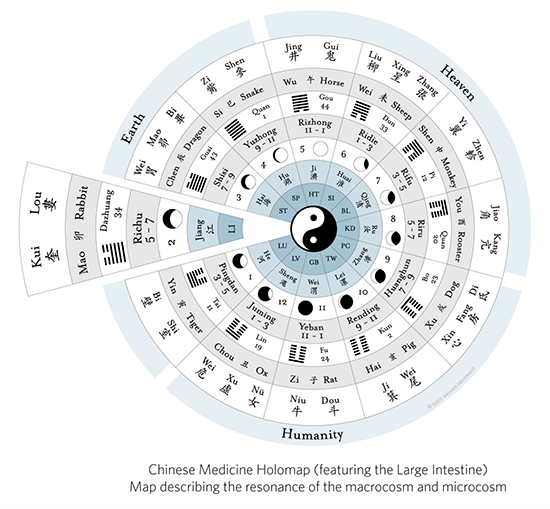


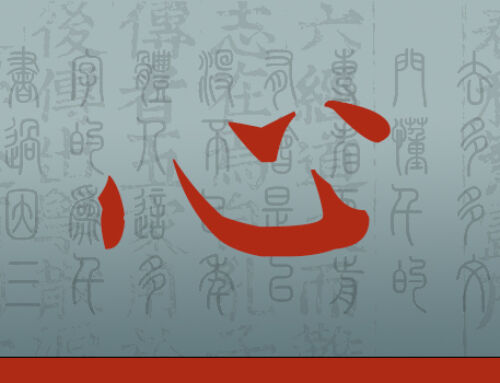
Thank you, Heiner, for this article. Mr. Trump provides an excellent exemplar for understanding your work on Large Intestine point names, right down to his constant brandishing of his index finger!
I have to say, I’m a little disheartened now. While never for a moment believing (as a Canadian) that he would be elected, I dared to hope some good may come of it all, since his status as a political outsider could theoretically put him in the position of being a true leader (rather than some sort of toadie concerned only about being re-elected). Now that I see him through your eyes as a shining example of Large Intestine pathology, I’m back to being shocked and dismayed.
But I enjoyed the article all the same!
Thank you much for your interest in this piece, Steve! I still distinctly remember your lively presentation within our “Acupuncture Points Research Club” on the point names of the Large Intestine 17 years ago. The analysis is far from done at this point, and while I am trying hard to look for some kind of silver lining here during the parts that are still to come, I am mostly in a state of shock and dismay myself.
After reading your second installment, I was reflecting upon Confucius, and how despite being the model for all that was exemplary in governance, he himself was denied a post until the end of his life.
Hitler seized power but only after already being popular. Trump likewise rode into power on the whims of the masses. Is it possible we are not drawn to the humble and conscientious (like Confucius) for our leaders, but to bombast? Do we mistake that for vision and for leadership qualities?
Meyers-Briggs evaluations of leaders, politicians and government officials consistently identify them as ‘Judging’. In other words, their minds are made up beforehand, and the job is simply to bring about what they desire, through political spin and machination. A grass-roots ‘due consideration’ kind of government is what we’re sold, but is not what occurs. Note that these individuals are already in office, not running. They won their campaigns.
Perhaps, then, the fault is within us all. We find ourselves looking for the strongly opinionated judgemental individual during election time, mistaking them for a leader. we don’t subscribe to “A wise man never really knows the answer”. So perhaps we have ourselves to blame
Ein herzliches “Hallo” aus Deutschland, lieber Heiner,
ich kann mich nicht erinnern, dich so politisch engagiert erlebt zu haben und so schockiert…falls ich damit richtig liege. Ich habe ja viel von dir und meinen daoistischen lehrern in den vergangenene 30 Jahren lernen dürfen und hatte, unabhängig von deinem Artikel, schon vor der Wahl Trump prognostiziert, dass er US-Präsident werden wird und dass gefährliche Zeiten der Demonstration von Macht, Stärke, Krieg und materiellen Auswüchsen kommen können…auch in Europa natürlich! Auch hier sind sehr ähnlichen Entwicklungen im Gange…! Und das in einer Zeit, in der das Yin ja im jahreszyklus betrachtet noch zunehmen wird…wir also ganz anders leben und agieren sollten!! Ein wenig bestätigst du das jetzt…leider!
Dennoch mein Dank an dich, dass du den Kampf angenommen hast, dich eben auf deine Art und in deinem Metier zu wehren gegen diese Strömungen…!
Von Herzen grüßt Joachim
A warm “Hello” from Germany, dear Heiner,
I can not remember to have experienced you so politically committed and so shocked … if I am right with it. I have been able to learn a lot from you and my Daoist teachers in the past 30 years, and so, independently of your article, before the Trump election I prognosticated that he will become US President and that dangerous times of the demonstration of power, war and material excesses maybe can arise … also in Europe of course! Also here are very similar developments in progress …! And at a time when the Yin is still growing in the year cycle, we should live and act totally different from what we are doing!! A little you confirm this now … unfortunately!
Thanks for your work and for your idea to fighting back against these ideas in your way and your professional area…!
From my heart Joachim
A brilliant article. Very sobering and insightful. I love the macrocosmic/microcosmic parallel of the diversity we need both in our large intestine flora as well as in our society if we are going to remain healthy and thriving. Indeed very scary times around the world. We need more sheng ming!
I found this such an interesting article. Now if would be even more fascinating and instructional to go back and do similar analysis of, perhaps, Bill & Hillary Clinton, and especially B. Obama. Add Mr. Bush to the list, too, while you are at it.
Hillary especially is an intriguing character; it was under her (and BO’s) watch that a prosperous country, Libya (no enemy of the USA), was utterly ruined and its leader murdered. Her response, whilst cackling madly? “We came; we saw; he died.”
BO somehow managed to gain a Peace Prize while during his presidency America dropped 26,171 bombs in 2016 alone, never mind the previous 7 years. All on countries that did not threaten and are not, and never were, enemies of the USA. Nary a word of criticism from the media.
Pres. Bill Clinton was responsible for the carpet bombing (cluster bombs) of Serbia for 78 days, supposedly a NATO project – but it was really just one more American warmonger having his way. With the full support of his wife, Bill Clinton gave the orders for both the 1995 and 1999 NATO bombings of the former Yugoslavia. His punishment? None. He still travels the world giving speeches that cost each listener hundreds of dollars to attend. He remains unaccused and unindicted.
Same with George Bush II. Iraq – well, I don’t have to tell you about Iraq, do I.
In classical Chinese thought, is there such a thing as being born with extraordinary good luck? While I’ve done some reading, I don’t have your depth of understanding. Possibly you understand why these four war criminals walk free and why that materialist Trump can do nothing right, only 2 months into his job.
What archetype (pathological or healthy) might these four persons represent? Inquiring minds want to know. Please exert your considerable knowledge and powers of expression to inform us.
Mille grazie.
– Missy.
Please, can you respond to my questions, above, as to why some persons, no matter how wicked, vicious and immoral, do not appear to receive any punishment on this earth? I’m referring to politicians.
Hi Missy,
Assistant for Dr. Fruehauf here. I apologize for the delayed response. He has been in China on business this spring and summer and has not returned yet. Thank you for your insights and questions. I can say that the nature of the article was not to wax poetic on the politics of Donald Trump as much as it was to illuminate the symbolism of the pathological Large Intestine archetype as it pertains to classical Chinese medicine. The illustrations of parallel periods in history were also presented, though the title might lead one to believe it’s political in nature. I suspect Heiner is less concerned with modern political figures, as it were. Without speaking for him, I can say that I don’t believe he has attempted to make direct correlations between the personal and professional histories of modern political figures with the symbolism of the organ networks of Chinese medicine. That said, I’m sure it’s a worthy topic. He is incredibly busy teaching, researching, and working with Classical Pearls, but perhaps he will be able to reply directly when he has time this fall. I will keep you posted. Thanks again for your insights and questions.
Many thanks, CCM, for your response. Yes, I understand what you are saying. But we all know – yes, we do – that there is a big hatred for Trump without which this article would have come into existence.
I meant to say that without the big hatred for Trump, the article on the Large Intestine archetype would never have been written. Left out the “never”. :) Thank you for allowing me to correct my comment.